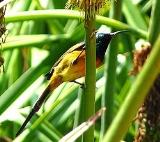
Orange-breasted Sunbird
Encyclopedia
The Orange-breasted Sunbird, Anthobaphes violacea, is the only member of the bird genus Anthobaphes although it is sometimes placed in the genus
Nectarinia
. This sunbird
is endemic to the fynbos
habitat of southwestern South Africa
, but also occurs in parks and gardens.
The head, throat and mantle of the male are bright metallic green. The rest of the upperparts are olive green. The upper breast is metallic violet and the lower breast is bright orange, fading to paler orange and yellow on the belly. The tail is long and blackish, with elongated central tail feathers, which extend some way, belong the other feathers.
The female has olive-greenish grey upperparts and olive yellowish underparts, paler on the belly. The wings and tail is blackish. The juvenile resembles the female.
The call is a twangy, weak ssharaynk or sskrang, often repeated several times.
this sunbird is associated with Erica
s, from which it takes nectar, insect
s (often taken in flight) and spider
s. It breeds when the heath flowers, typically in May. The male defends its territory aggressively, attacking and chasing intruders.
This tame species is a common breeder across its limited range, and is an altitudinal migrant
, moving to higher altitudes during the southern summer in search of flowers. It is gregarious when not breeding, forming flocks of up to 100 birds.
Genus
In biology, a genus is a low-level taxonomic rank used in the biological classification of living and fossil organisms, which is an example of definition by genus and differentia...
Nectarinia
Nectarinia
Nectarinia is a genus of bird in the sunbird family, Nectariniidae. What species belong to it has been highly contentious for many decades. Towards the late 20th century, the dominant trend was to use it to group all "typical" sunbirds. More recently it has been split up into many genera, but this...
. This sunbird
Sunbird
The sunbirds and spiderhunters are a family, Nectariniidae, of very small passerine birds. There are 132 species in 15 genera. The family is distributed throughout Africa, southern Asia and just reaches northern Australia. Most sunbirds feed largely on nectar, but also take insects and spiders,...
is endemic to the fynbos
Fynbos
Fynbos is the natural shrubland or heathland vegetation occurring in a small belt of the Western Cape of South Africa, mainly in winter rainfall coastal and mountainous areas with a Mediterranean climate...
habitat of southwestern South Africa
South Africa
The Republic of South Africa is a country in southern Africa. Located at the southern tip of Africa, it is divided into nine provinces, with of coastline on the Atlantic and Indian oceans...
, but also occurs in parks and gardens.
Characteristics
As with other sunbirds the bill is long and decurved, that of the male being longer than that of the female. The bill, legs and feet are black. The eye is dark brown.The head, throat and mantle of the male are bright metallic green. The rest of the upperparts are olive green. The upper breast is metallic violet and the lower breast is bright orange, fading to paler orange and yellow on the belly. The tail is long and blackish, with elongated central tail feathers, which extend some way, belong the other feathers.
The female has olive-greenish grey upperparts and olive yellowish underparts, paler on the belly. The wings and tail is blackish. The juvenile resembles the female.
The call is a twangy, weak ssharaynk or sskrang, often repeated several times.
Habitat
Obviously due to its restricted range within fynbosFynbos
Fynbos is the natural shrubland or heathland vegetation occurring in a small belt of the Western Cape of South Africa, mainly in winter rainfall coastal and mountainous areas with a Mediterranean climate...
this sunbird is associated with Erica
Erica
Erica ,the heaths or heathers, is a genus of approximately 860 species of flowering plants in the family Ericaceae. The English common names "heath" and "heather" are shared by some closely related genera of similar appearance....
s, from which it takes nectar, insect
Insect
Insects are a class of living creatures within the arthropods that have a chitinous exoskeleton, a three-part body , three pairs of jointed legs, compound eyes, and two antennae...
s (often taken in flight) and spider
Spider
Spiders are air-breathing arthropods that have eight legs, and chelicerae with fangs that inject venom. They are the largest order of arachnids and rank seventh in total species diversity among all other groups of organisms...
s. It breeds when the heath flowers, typically in May. The male defends its territory aggressively, attacking and chasing intruders.
This tame species is a common breeder across its limited range, and is an altitudinal migrant
Bird migration
Bird migration is the regular seasonal journey undertaken by many species of birds. Bird movements include those made in response to changes in food availability, habitat or weather. Sometimes, journeys are not termed "true migration" because they are irregular or in only one direction...
, moving to higher altitudes during the southern summer in search of flowers. It is gregarious when not breeding, forming flocks of up to 100 birds.

